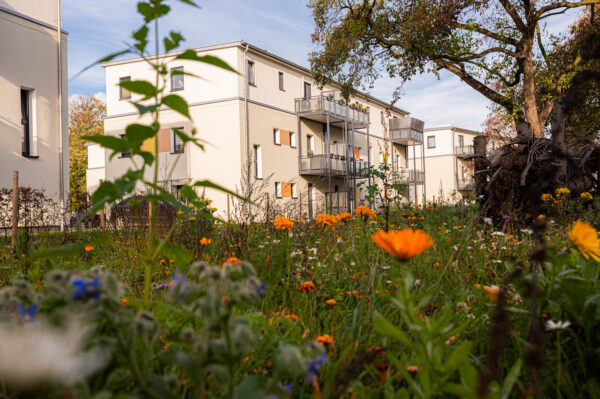Sustainable Materials and Products
Using sustainable materials and products for construction, refurbishment and demolition work has an impact on the climate and the environment and is becoming increasingly important in construction processes. Sustainable construction methods such as modular timber or hybrid methods have a lower energy consumption and reduced carbon emissions over their entire life cycle. They are also increasingly used in our construction projects. We also largely use mineral wool for insulation, which has less of an impact on the environment than polystyrene, especially because it is more suited for recycling.
Carbon Footprint of Construction Materials
In the reporting year, we integrated the principle of life cycle assessments into our planning process. These assessments are based on our investigation of the climate impacts and the energy consumption of six construction methods over the entire life cycle – that is, from the manufacture of the construction materials to the operation and final demolition. This enables our planning departments to determine the carbon footprint of the planned development and new construction projects early on in the project planning and include this in their design. The design and implementation of proven sustainable construction projects helps us to include subsidies in the financing and achieve sustainable construction certification.
With the help of our analysis methods, we can also calculate the greenhouse gas emissions generated upstream from the materials used in the construction of our new buildings, also known as gray emissions. In 2022, this figure came to approximately 125 thousand metric tons of CO2 equivalents.
We are also pushing for transparency on environmental impacts over the full life cycle with regard to the materials and products we use in energy modernizations. In a detailed analysis of the historical data of purchased goods, we calculated the carbon footprint for the materials and services employed and identified the relevant hot spots. They relate particularly to windows, insulation materials and heating systems. The next step involves integrating these calculations into the data systems.
Circular Economy
Another important aspect in the sustainability of materials and products is their recyclability. Vonovia is committed to using environmentally sound raw materials and production methods, as well as sustainable and recyclable construction materials. In order to lower the environmental impact of construction, more construction materials must be recycled and more construction materials must be made from recycled products. This reduces the need to produce new materials, which is intensive in terms of energy and resource.
The construction materials that we use should be reusable and highly recyclable. This means it must be possible to demolish constructions and reclaim the original components. Timber structures that are held together with screws and joints perform very well in this regard. We have partnered with Madaster – an initiative to develop a global cadastre for materials – for two years now. The online platform functions as a materials database. We use it to manage data about the materials that go into our properties and create material passports. These documents contains information about the quality, origin and location of the materials used in a particular building. They also provide an insight into the financial value of a building and its materials, while also giving users an indication of the value of these materials in the circular economy. We intend to gradually introduce these material passes for all of our new buildings.
We aim to introduce recyclability as a criteria in our planning, tendering and awarding processes in the future. We intend to analyze the environmental impacts and life cycle costs (manufacture, operation, maintenance, renovation, demolition) of construction materials and products and establish the importance of circular economies in our product manual in the future.
The product manual already contains information regarding the carbon footprint and proportion of recycled materials for the products used in the design of open spaces. Pursuant to the requirements in the manual, we only use wood products that come solely from FSC-certified sources for playground equipment and insect habitats. The product manual is mandatory for our partners and application of the manual is part of the contractual agreement. We run training workshops to inform our employees in the central procurement department about the importance of sustainability in their day-to-day work and due diligence in the supply chain and their own department.
We want to push sustainable product innovations. We therefore organized an innovation competition during the dialogue process "Perspectives on the Future of Construction," which premiered innovative materials and products. We have already used the winning materials presented in the competition to show as examples, e. g., for the construction of a daycare center in Weitmar, Bochum.
We aim to install energy-efficient electric devices during refurbishments and in new constructions while also increasing the proportion of products made of, for example, secondary raw materials. In response to the increasingly tight rules surrounding the disposal of materials, we avoid using hazardous or toxic substances from the outset.
A large number of the apartments in our portfolio were not built by Vonovia. In some cases, there are materials in these buildings that were the latest technology available at the time of construction, but are now considered hazardous upon release. Potentially harmful materials, such as asbestos, “old” artificial mineral fibers (AMFs), polycyclic aromatic hydrocarbons (PAHs), or lead-based paints in existing buildings, are usually removed during maintenance or refurbishment projects or when a new tenant moves in and replaced with suitable materials. Whenever the disposal of hazardous or contaminated building materials requires careful professional handling, we expect all of our service providers to comply with applicable legislation and regulations, particularly those concerning health and safety and environmental protection. Our employees receive regular training on these subjects.


